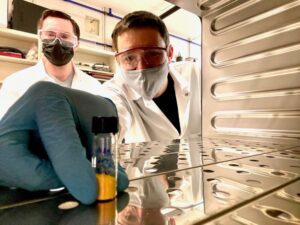
Luther McDonald, Associate Professor in the John and Marcia Price College of Engineering’s Department of Civil and Environmental Engineering, has received a 2023 Countering Weapons of Mass Destruction: Nuclear Forensics Research Award, with a budget of $1,395,000 to support 36-months of laboratory experiments and student development.
For decades, the nuclear forensic community has wanted to use oxygen stable isotope ratios (18O/16O) to determine the origin of materials, but the process was unclear. Since 2017, Luther’s research team has collaborated with experts in stable isotope geochemistry at Lawrence Livermore National Laboratory (LLNL) through the Seaborg Graduate Student Fellowship Programs. Nuclear engineering students at the U would make samples in Luther’s laboratory, then use the unique facilities at LLNL to characterize the oxygen isotope ratio. Recently, the team discovered that certain uranium processing conditions yield distinct oxygen isotope ratios on the final product. With funding from the U.S. Department of Homeland Security, the U team will use this recent discovery to create standardized U-oxide samples in controlled environments. They will then work with LLNL to use three techniques: bulk fluorination, laser fluorination, and thermogravimetric analysis with isotope ratio infrared spectroscopy (TGA-IRIS) to analyze the oxygen composition of the samples.
This collaboration combines the University of Utah’s radiochemistry and nuclear material synthesis expertise with LLNL’s stable isotope geochemistry skills. Completing this research will help link production history with the production location in a nuclear forensics’ investigation.
Continue reading at the Department of Civil And Environmental Engineering.